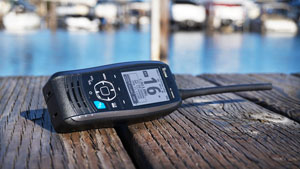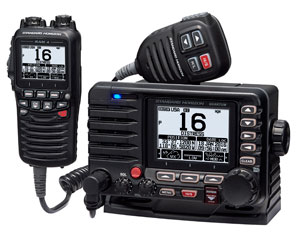For more than a century, marine radio has been a boon to all who work on the water, providing first for improved safety and, over time, becoming an indispensable operational tool. In recent years, it may not have experienced the “mobile revolution” that smartphones have brought to life ashore, but it has acquired many new capabilities.
So, despite competition from newer technologies, radio remains a bedrock tool for vessel operators.
“For our organization, we live and die by radios — all our ship communication to and from helicopters, boats and dispatchers all comes via VHF radio,” said Brian Junes, vessel and facility director for the Columbia River Bar Pilots. “As the technology has advanced so has the signal clarity, and some of the radios have features and functions that simply weren’t available 20 years ago.”
The type of vessel helps drive the nature of the radio communications implemented. Domestic and international agreements further frame choices. Larger oceangoing vessels must be equipped with long-range radio communications, while smaller passenger vessels used on coastal and near-shore routes require less powerful equipment. Both are categorized as compulsory. Some vessel types — recreation and pleasure craft, for instance — have far more latitude and, since no specific equipment is required, they are categorized as voluntary.
Adding features and functions
Smaller commercial vessels have come to depend on very high frequency (VHF) handhelds for internal and external communications. The VHF maritime mobile band encompasses the frequency range between 156 and 174 MHz.
Beyond that, the name of the game is cramming more features and functions into the basic transceiver design. For example, some now include both marine and land mobile frequencies, as well as programmable channels for navigation and communications.
Most marine radios are predominantly voice-based, but most also offer additional communication capabilities such as digital selective calling (DSC), which is a component of the internationally recognized Global Maritime Distress and Safety System (GMDSS).
 |
|
Furuno’s black-box FM-4850 radiotelephone is a multipronged tool: VHF, GPS, AIS, loud hailer, NMEA 2000 interface and DSC calling. |
|
Courtesy Furuno |
Hans Rooker, national sales manager at Standard Horizon in Cypress, Calif., said DSC has been on the market for several years, but it remains something of an emerging technology with hand-held radio. It is really more of a safety feature, he noted. If you register the nine-digit Maritime Mobile Service Identity (MMSI) number and program it into the radio, it becomes like a phone number.
“You can ring another individual and select a channel and put them on that channel,” Rooker said.
That cuts down on the time and trouble of having to hail someone on different channels. It also is useful for the U.S. Coast Guard, making it easier for a mariner to issue a distress call that, because of the built-in GPS, will automatically provide a position.
“They will get (the number) with your position information … so they know who you are and can contact you,” he said.
Many new VHF radios include GPS and also have advanced features such as the automatic identification system (AIS), according to Jeff Kauzlaric, advertising and communications manager at Furuno USA in Camas, Wash. This allows the radio to communicate with transponders on other vessels to identify and monitor their movement — a useful feature for watch-standing personnel.
The AIS can work as a so-called mesh network, meaning that AIS messages can be forwarded between different sending and receiving units to extend the overall range of operations. However, this is a more common feature with high-end systems. AIS operates on VHF channels 87B and 88B.
A more basic capability also becoming common in radios is incorporation of a loud hailer to improve shorter-range communication between vessels or among crew, Kauzlaric said.
 |
|
Icom America’s M93 floating hand-held VHF radio has built-in GPS to provide location, bearing and speed. |
|
Courtesy Icom America |
David McLain, senior manager at Icom America of Kirkland, Wash., also cited strong interest in built-in AIS and GPS. “Everyone looks for NMEA 2000 plug-and-play” capability, he said, a standard that facilitates interconnection of marine sensors and display units and is compatible with the controller area network (CAN) used on some engines.
McLain said Icom’s lineup includes a “TiVo-like” playback feature, which provides about one minute of playback on the company’s M73 hand-held model and two minutes on the fixed-mount M506 and M605. “Our products are also unusual in that they are built to ‘mil-spec’ (military specification) standards,” he said.
Rooker said one of the newer features at Standard Horizon, which offers both hand-held and fixed-mount radios, is built-in scrambler capability for private conversations.
“A lot of commercial fishermen will use that because they don’t want the public listening to find out where the hot spots are,” he explained.
High-end marine radios often include the FM broadcast band so users have the option of listening to that for news and entertainment. Rooker said that in case of accidental immersion, the handhelds from Standard Horizon also float.
“We offer a lot of newer radios that are programmable,” he said. “Out of the box it comes pre-programmed with marine frequencies, and with the software provided you can program additional frequencies. Once you set up the radio and the DSC functions, you can use it to program additional channels.”
Modern value from proven technology
Despite the advance of cellular and satellite technologies, Kauzlaric said it is important to note that VHF radios are still required by the Coast Guard on most vessels, “and they really help when trying to hail, wake up and communicate with larger vessels in traffic” — especially when you don’t have their number. He also cited the importance of radio access to the Coast Guard’s Rescue 21 system, which initiates distress response if mariners need immediate help.
 |
|
Standard Horizon’s fixed-mount GX6000 has all of the latest communications features, including “plug-and-play” NMEA 2000 interface and integrated voice scrambler. |
|
Courtesy Standard Horizon |
“Rescue 21 has saved lives,” Kauzlaric said. Although cellular service is an option, “we all know how cell craps out from time to time, and batteries die.”
While VHF is installed on many vessels because it is a requirement, usage has decreased due to the availability of cellphone and satellite phone capabilities, Kauzlaric said. Rooker agreed and said that may mean fewer new features on the horizon for marine radio.
But marine VHF can be stretched in new directions, according to Hugh Lupo, owner of New England Marine Electronics in Norwalk, Conn. He is also a trainer for the National Marine Electronics Association (NMEA), a U.S.-based trade association that sets standards for communication between marine electronics systems.
Among the newer developments in the maritime band, Lupo noted the adoption of phase-shift keying 31 (PSK31) for messaging using a dedicated modem. A signal that sounds to the human ear like a whistle is decoded by a computer soundcard and software, and then turned back into a text string on the computer display. Like other narrow-band digital modes, PSK31 can often overcome interference and poor propagation conditions where voice or other methods of communication fail.
Pactor modems, combined with the SailMail radio-based email system, can serve vessel operators in areas beyond line-of-sight radio links to the internet, Lupo said. However, SailMail is intended only for non-commercial use.
Lupo said there are also some UHF frequencies used on vessels, mostly among the crew, “but those are shared frequencies, not strictly for maritime use.”
Some of the benefits of marine radio functionality are up to the user. McLain said the industry still has a problem getting customers to understand that the advantages of DSC in an emergency depend on people registering and, in effect, “hooking up that little red button.”
“Some people think they have a cellphone and that’s enough, but if something bad happens, do you know the cell number of the boats that are nearest to you?” he said.

